
The Quadratic Formula
A derivation of the quadratic formula interpreting monomial expressions as lengths and areas.
Steve Trettel
|
Set Up
The operations of addition and subtraction are often thought of geometrically as
concatenating lengths:
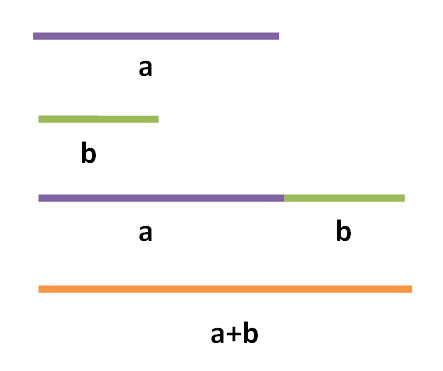
Subtraction can also be looked at in the same way: as a difference of lengths.
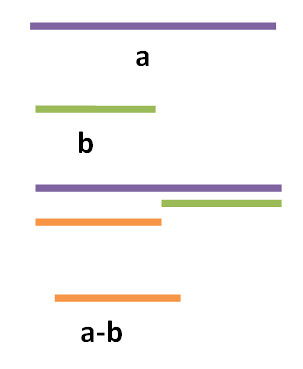
Here I am going to describe a geometric interpretation to multiplication, division,
squaring, and square roots that follows much along the same lines.
Nothing here is new; indeed most of it may be obvious,
but I have found that often we learned multiplication and division so
long ago that we blindly follow the rules on paper without considering the
geometry behind it. We memorize things like FOIL to expand a product,
and we follow algebraic “rules” to solve equations.
What follows will all be early high school stuff, but from a different perspective.
Multiplication
We are going to interpret the multiplication of two numbers as being the area formed by a rectangle. This means we are going to consider the map
as the map
From now on though, we won’t worry about the symbolic definition of multiplication,
or even how to compute it.
Instead, we are going to replace our current knowledge of
multiplication with the following picture, and take it as our definition.
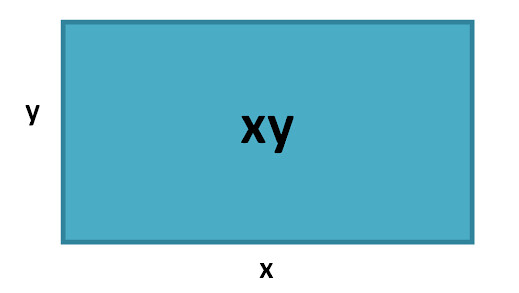
Division
Our notion of multiplication allows us to take two lengths and produce the area of a rectangle with them as the sides. Since division undoes multiplication, we are able to interpret it as undoing our above operation. That is, given an area of some rectangle and one of the side lengths, division will produce the length of the unknown side.
As input the division operation then requires both an area and a length, and it gives a length as output.
As before, it will be much more useful to supplement this notion with a picture
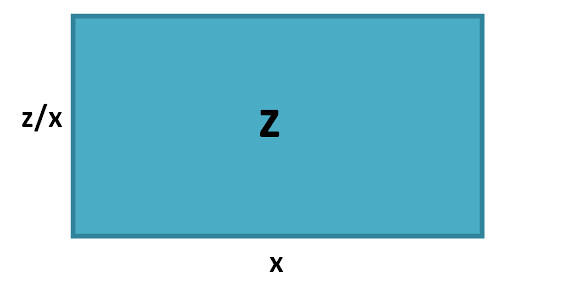
Squaring and Square Roots
For our purposes here, these are simply special cases of multiplication and
division, when instead of dealing with a general rectangle we have a square.
The operation of squaring a number is a map
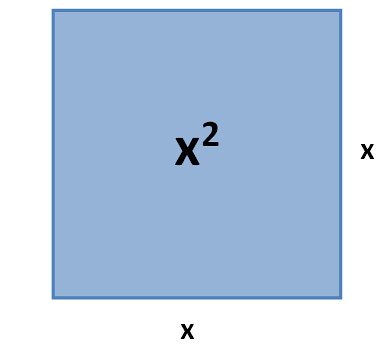
Since the square root is its inverse, we can likewise say that the square root
provides us with a map
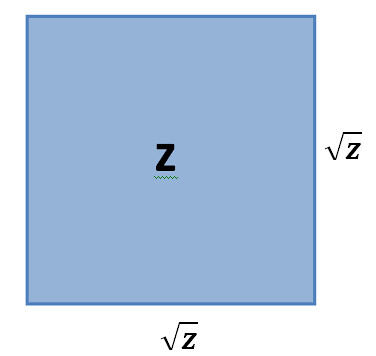
Factoring
So we got a way of looking at addition, subtraction, multiplication, division, squaring,
and square roots in terms of lines rectangles and squares. Great. What use is it?
Well, it doesn’t provide us with any new information, but at least for me it helps
give some insight and make easier to remember the basic formulas in algebra.
I’ll just put a few examples here; but this kind of reasoning can be used for any
problem.
Factoring
This equation really is taking about the area of a square of side length

Lets see how we can re-arrange this pictorially and in the end come up with a
different symbolic expression. If we rotate the orange square,
then its side of length
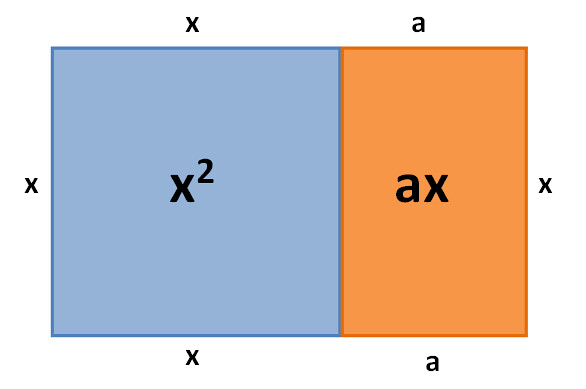
This lets us combine the two into a single rectangle with vertical side length
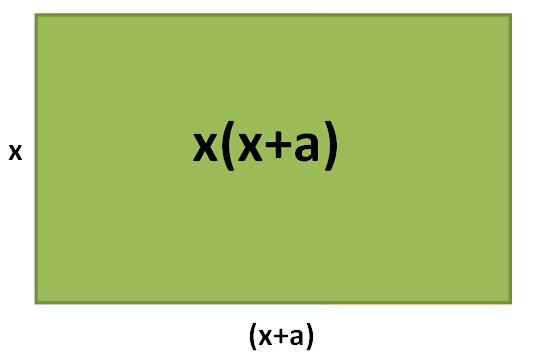
Using our interpretation of multiplication, the area of this new rectangle is the product of its side lengths. This amounts to a pictoral demonstration of factorization, namely that
While this rule is probably obvious to the point that it doesn’t seem to need justification, think when you first learned it. Factorization (at least for me) was presented as a formal rule, that you could “pull an x out”, and it was justified by showing that it is just the distributive property in reverse. While true, this doesn’t provide much insight unless the distributive property was intuitive at the time.
Factoring
Here we will give a visual proof for the factorization of
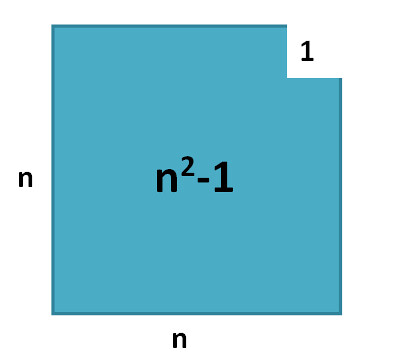
What if inside this picture we draw a square with side length

The original goal was to factor our expression; so we need to some how take this and form it into a single rectangle. What about if we take the red rectangle off the top and put it alongside the green square? Notice that both the square and the rectangle have a side of length n-1, so they will match up perfectly.
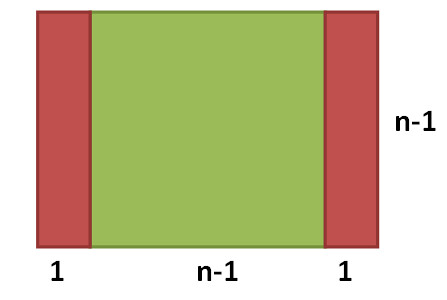
Nice! Its one rectangle, just like we wanted.
Combining them (adding together the 3 horizontal lengths to form a
single rectangle)
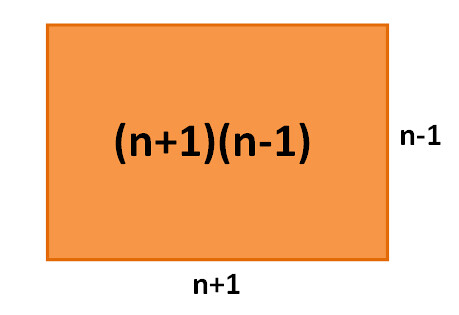
Just like before, all we did was cut and slide pieces around, so this new rectangle has the same area as our original square with a bite out of it. That allows us to equate the two
Expanding
What if we want to convert an expression that is written as a product into a
sum of different terms? This is essentially the opposite process of
the above examples; we would have to start with a rectangle and find
a way to break it up in some “natural” fashion. For a simple example,
lets consider
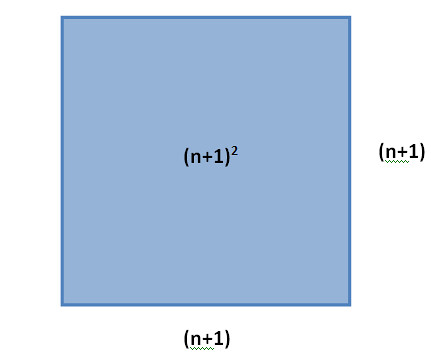
Since we “know” the number
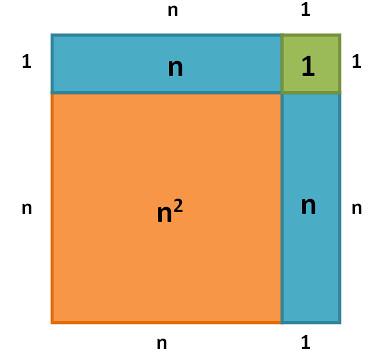
We can further simplify this by decomposing the square and putting the two blue rectangles of equal size near each other:
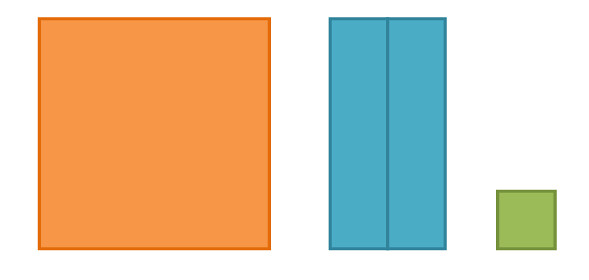
Merging the two blue rectangles, we now have a collection of 3 shapes (and thus our expression for area will be a sum of three terms).
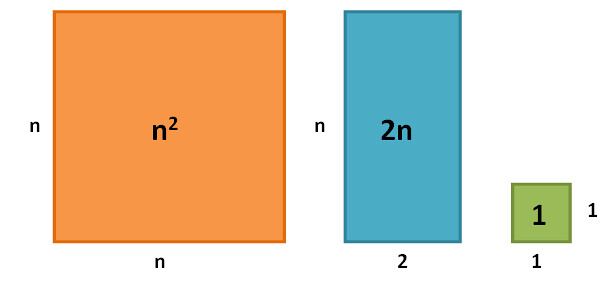
This provides a simple geometric picture behind the identity
Expanding
What about if we start with a more general rectangle instead of a square?
To make it manageable, say we have the product
This product is equivalent to the rectangle below:
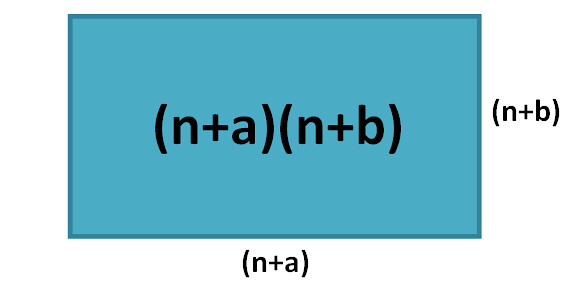
Since both sides of the rectangle again involve the variable
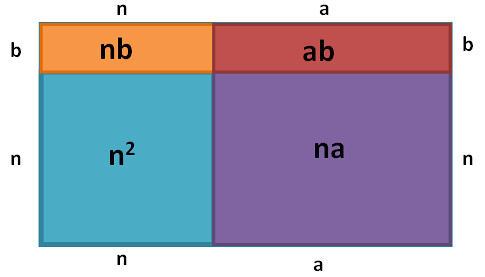
We can break these up, and combine the orange and purple rectangles to form
another rectangle (both share a side length of
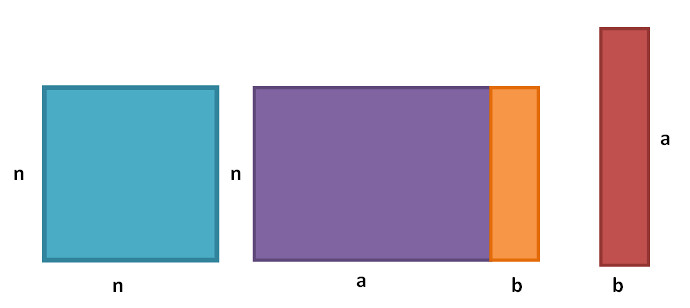
This leaves us with the following 3 terms:
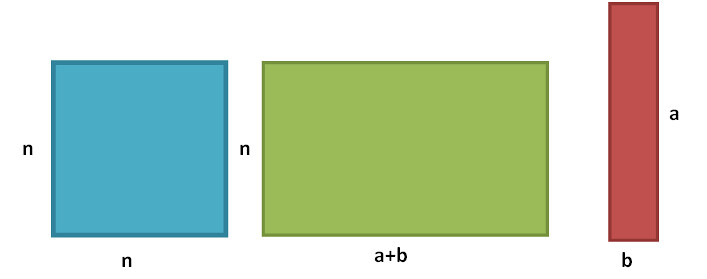
Looking at the new expression for the areas of each piece,
Zeroes of Polynomials
Now that we know how to interpret the arithmetic operations geometrically, as well as how to factor and expand expressions, we can take our next step towards solving the quadratic formula by discussing what it means to solve an equation.
To do an explicit example, say we have the quadratic equation
Drawing this expression out in terms of squares and rectangles:

The large purple rectangle has one side length of

Lining 3 of these new purple rectangles up end to end will give us a side length of
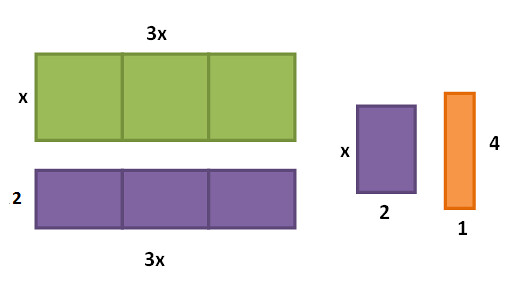
We still have two left over pieces though. The leftover purple rectangle has a side
length x, and so does the short side of the green rectangle.
Lets stick it there for now.
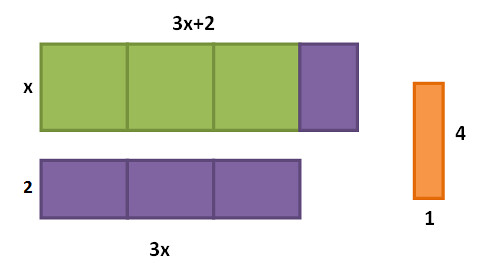
The short side of our all-purple rectangle has side length 2, which we notice is exactly half of the length of the orange one. Lets cut it in half quick
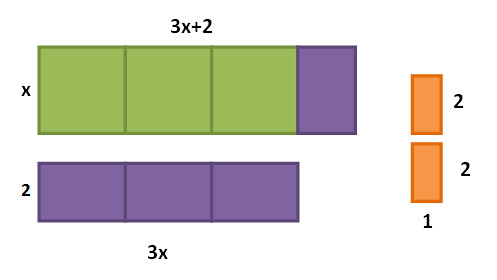
If we line the two orange pieces up right next to each other,
they will form a
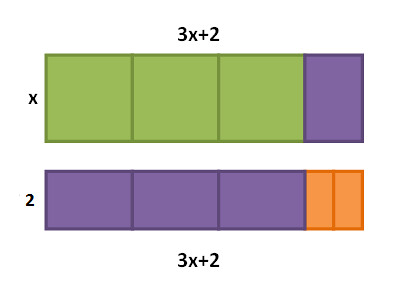
Now look at this, the horizontal side lengths of both our top and bottom rectangles are the same!
That means we can also slide them into each other.
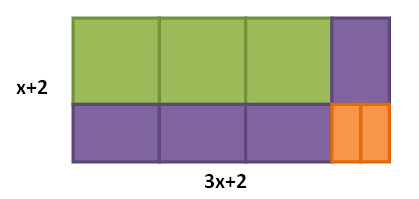
Merging them all into one rectangle, we have found a way to see the area in a whole new way
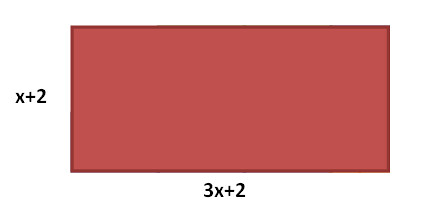
Now, all the tricky geometry is done.
Remember, this was originally the left side of an equation which equaled zero.
What that means then is that our rectangle has zero area!
The picture above definitely does not have zero area, but it has just been
a conceptual tool. Solving the original equation means finding the value(s)
of
The only way for a rectangle to have zero area is for it not to exist,
so we need the values of
By using geometric reasoning then, we have converted the original quadratic equation
into two linear equations, which are easy to solve.
This gives us the solutions for
While we are using geometry as an intuituion pump to understand the manipulations of algebra, we
are not bound by it.
Insights about Higher Degree
The above solutions are of course exactly the same as what we would have obtained if we had just used the quadratic formula. However we have gained something more following our geometric approach; because we represented the original quadratic equation as describing an area (because its highest order term is a square), we saw that we could satisfy the equation by making either side length of the rectangle be zero. Thus, this method provides us with some intuitive justification for why there are 2 solutions to a quadratic (try for yourself an example of a quadratic with one solution, a so-called double root. The final rectangle produced by the method above will be a square, so this method shows again why you should expect only one solution in that case!).
Without actually doing it, we could extend this reasoning to the third dimension (involving variables cubed). If we assembled a bunch of cubes and rectangular prisms (representing the terms in a general cubic equation) into one larger rectangular prism, we would then have three independent side lengths we could set to zero to make our prism have zero volume. Thus, we expect the general cubic to have 3 independent solutions. And onwards to higher dimensions; we expect an equation of order n to have n solutions. Pretty nice!
Deriving the Quadratic Formula
We now have enough experience to tackle our main goal: deriving the quadratic formula
using our geometric interpretation of the terms of a polynomial as a guide.
The quadratic formula provides the solutions to a general equation which
is quadratic in
If we were to draw this equation out pictorially, the left hand side would look something like this:
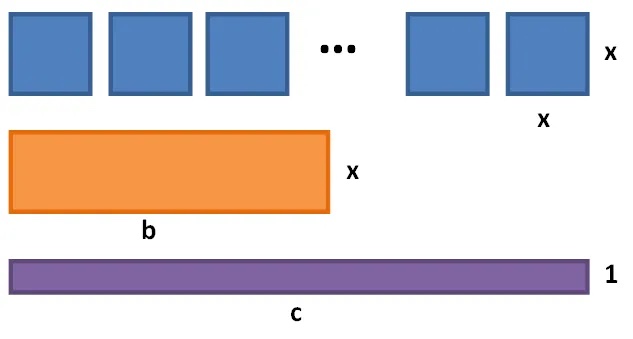
Where there are a boxes of side length
First things first, instead of having an equation equal to zero,
it might be more useful to have an equation where we have something=something.
(we already saw a method of solving equations equal to zero by factoring above,
so let’s try somethign new!)
In this way, as we are solving it, there will be terms on each side of the
equals sign to play around with.
Under our interpretation, these two terms will both be areas;
so we will have two piles of shapes with the same total area,
and our goal will be to shuffle them around until we can read some information off.
So, first off, we will move the constant term to the other side.
Now, this is supposed to be a problem about areas, and the original trouble was
caused by the coefficient
Here we have one possible issue: if we want the equation to represent two collections of squares and rectangles which share the same area, how are we to do this when the right hand side is negative? It’s good to keep in mind that the “area” interpretation is just a helpful visual device; the fact that its “actually” negative here is ok, we can still draw it as a positive area and then just insert a negative sign when we get back to the symbolic form. Shuffling these constants hasn’t robbed the equation of any information (this new equation has the same solutions as the original), we can consider the following as our general form for the quadratic
This has a straightforward pictorial interpretation:
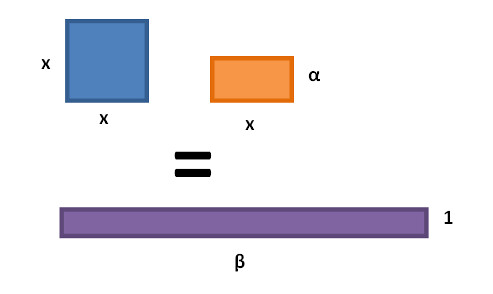
Our goal here will be to take this above picture, and move/recombine/squish the shapes in question without changing their areas, until both sides of the equals sign have a square on them. Once we have that, we will have two squares, each with equal areas, and hence with equal side lengths. Just like in the multiplication article, we are then able to reduce our problem to a simpler one by working with the side lengths only.
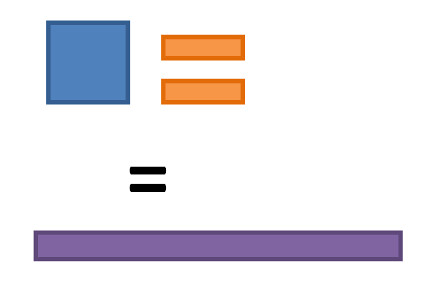
Now we can line the orange rectangles up alongside the blue square
(this works out because the long side of each orange rectangle is side length
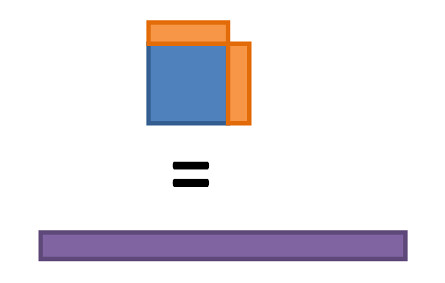
The top half of the equals sign is almost a square; its just missing one corner! To fix this, lets add a little square. Of course, to keep the quality if we add a square to the top we need to add one to the bottom too.
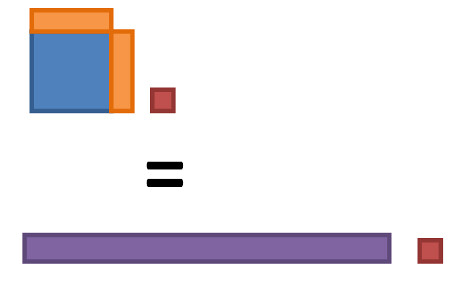
What size is this little square? Well, the only reason we added it was to “fill
in the hole” in the top square; and that hole has side lengths equal to the short
sides of our orange rectangles. Since the original orange rectangle had a side
length
Now, we added our little square to the top and it’ll fit perfectly, but the square dosen’t line up naturally with the bottom rectangle. That rectangle has short side of length 1, so we need to squish the red square into a rectangle with a side length of 1 (without changing its area of course). This isn’t hard to do;
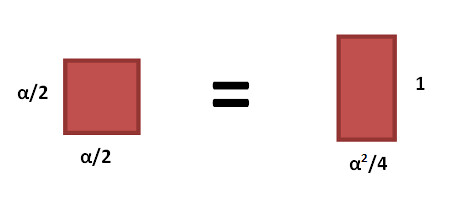
Now we have expressed this added area in two different ways (visualized by two different shapes), which makes it convenient to add to each side of the equation. Pushing the pieces together;
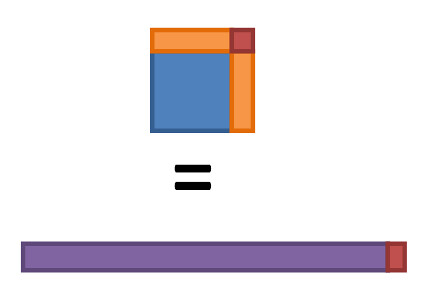
Nice! The top half of the equals sign has been formed into a square.
(In fact, if you were to step by step transcribe these pictures into symbolic
expressions, all we did was “complete the square”)
Let’s work on the bottom half now. To make things a little less cluttered,
I’m going to fuse the purple and red parts into a single bar (whose length
I will call for convenience).
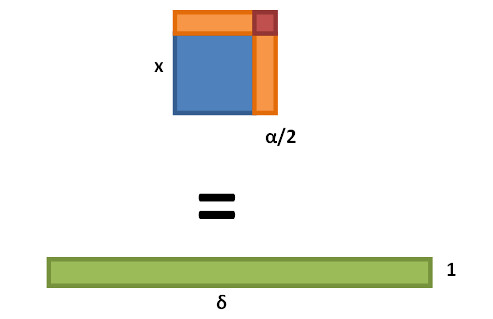
How do we take a given area and find the side length of a representative square?
Well, thats what the square root function is all about!
Lets “squish” this green rectangle into a square as shown

Putting this back into the equation with our top square, we have reached our goal

We have been careful to perserve the equality throughout all of this, so these two squares have the same area. This means that the side lengths on each side of the equality must be the same; and we have the equation
which we can rewrite as
To get back to our solution symbolically then, we need to know our formula for
Plugging this in and solving for
This gives us the solution in terms of our form for the quadratic;
but the formula is standardly presented for the “general form” with coefficients
Which can be simplified a bit to
So there you have it!
As a first step, lets cut the orange rectangle in half. Leaving everything else alone, we end up with this